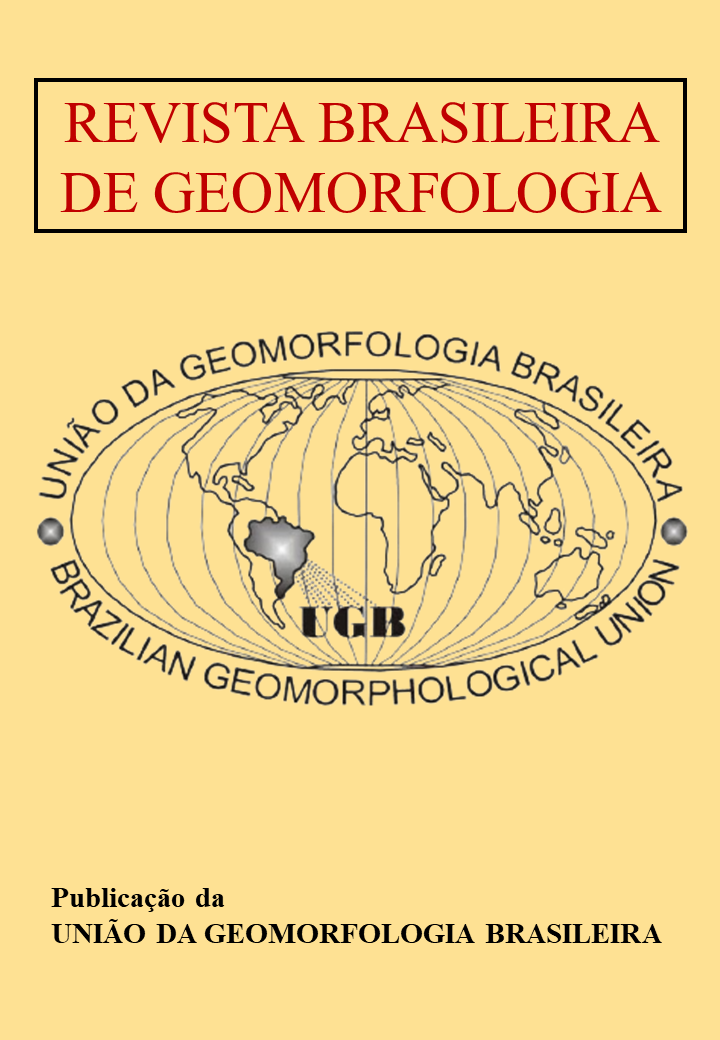Supported by:

The Revista Brasileira de Geomorfologia (RBGeomorphology - Brazilian Journal of Geomorphology) was established in 2000 with a focus on research related to the genesis, processes, evolution, and landforms. It encompasses the use and integration of laboratory data, geological records, morphometric indicators, remote sensing and Geographic Information Systems (GIS) tools, and modeling applied to geomorphology. The journal addresses the impacts of environmental changes on the Earth's surface, considering both natural and anthropogenic factors, and makes significant contributions to scientific production and the formulation of public policies.
RBGeomorphology publishes articles covering a wide range of topics, with the main ones including:
RBGeomorphology does not prioritize the publication of studies focused solely on specific method replication cases unless these studies have broader and more general implications that advance the understanding of geomorphological processes occurring on the Earth's surface and/or research methods and techniques.
The submissions pass through an editorial triage, before being sent to the reviewers. The editors can dismiss manuscripts that do not meet the minimum formatting criteria, scope, and journal content.
Regarding the content, the applied criteria are listed below:
Unfortunately, the amount of articles submitted to the RBGeomorfologia is bigger than the amount of which we can publish. Therefore, we make a distinction between the manuscripts of high scientific quality, with original research and advancement in geomorphological science from those who, even when presenting quality for scientific work, present little advances in the geomorphological science. Given the space pressure for publishing on the RBG, we reserve the right to reject those manuscripts that meet our standards in terms of science, but do not have sufficient originality and advanced material to merit publication.
The submitted manuscripts to RBGeomorfologia will pass through the process of double-blind peer review, that is, the anonymity of the reviewers and the authors in the evaluation process is maintained. The advisory board of evaluators (advisers ad hoc) is comprised of researchers which are exponents in Brazil and internationally, in several knowledge areas that are part of Geomorphology in its research, teaching, and extension activities.
Each reviewer has to fill a specific form from the Revista Brasileira de Geomorfologia, and at the end of this form, must indicate which modality the work being evaluated fits into. The reviewer also will have to make comments for the editor (justifying the ruling) and can follow the authors the work with their considerations. The manuscript will only be accepted if it has 2 (two) favorable rulings from the advisers. If one reviewer approves the publication and another does not, the Editorial Board will decide to reject the article or send it to a third reviewer.
The Revista Brasileira de Geomorfologia, between 2016 and 2022, had a publication periodicity of 4 (four) issues per year, with the publication of 12 (twelve) research articles per issue. From 2023 on, the journal started to work according to the CAP (continuous article publishing) system, aiming to guarantee more agility to the processes of the editing flow, maintaining the periodicity of publication of 4 (four) regular issues per year.
This journal offers free immediate access to its contents, following the principle of which providing scientific knowledge to the public for free provides greater worldwide democratization of knowledge. The journal does not charge any submission or processing fees.
Articles published in Revista Brasileira de Geomorfologia will be Open-Access articles distributed under the terms and conditions of the Creative Commons Attribution License (CC BY). The copyright is retained by the author(s). RBGeomorfologia will insert the following note at the end of the published text:
The Revista Brasileira de Geomorfologia is indexed in the following databases:
- BASE (Bielefeld Academic Search Engine);
- Clasificación Integrada de Revistas Científicas (CIRC);
- CrossRef;
- Diadorim;
- DOAJ;
- EuroPub;
- Journals for Free;
- Latindex;
- Open Science Directory (EBSCO);
- Portal de Periódicos (CAPES/MEC);
- REDIB;
- Scilit;
- SEER;
- ScienceOpen.com
- Scimago Journal & Country Rank (SJR);
- SCOPUS;
- SHERPA/RoMEO;
- Sumários.org;
- World Wide Science;
This statement defines the ethical principles adopted by the Revista Brasileira de Geomorfologia, as well as the best practices of the entire publication process of the works sent to the Revista Brasileira de Geomorfologia.
The Revista Brasileira de Geomorfologia adopts the principles and ethical guidelines established in the "Committee on Publication Ethics" (http://publicationethics.org/), and is thus committed to the best practices of publishing scientific papers. The principles of impersonality and confidentiality are guaranteed in the evaluation process, avoiding conflicts of interest. The Revista Brasileira de Geomorfologia is associated with the "Associação Brasileira de Editores Científicos" (http://www.abecbrasil.org.br), a non-profit association that brings together scientific journals, ensuring the standard and best practices for publishing scientific articles.
RESPONSIBILITIES
The Revista Brasileira de Geomorfologia is responsible for the implementation of the Declaration of Ethics and Best Practices in relation to all published works. In this way, the Revista Brasileira de Geomorfologia is responsible for supporting freedom of expression, being available to readers, authors and reviewers for any need, ensuring that all papers have the same evaluation criteria, maintaining the quality of the papers published and, Publish Errata when necessary. All articles undergo a blind peer review process and are subjected to anti-plagiarism procedures. The entire review process done by the reviewer is done in the journal's system, ensuring the protection and confidentiality of the reviewers. The Revista Brasileira de Geomorfologia adopts the Open Journal Systems (OJS) system for the management and publication of scientific journals.
Editors' Responsibilities
The editors have the responsibility of ensuring that all the papers have the same criteria without any type of discrimination. All the papers have received the same reviewer criteria adopted by the journal, without any type of discrimination, and only academic/scientific merit was considered. The editors have adopted necessary procedures, defined by the journal, and in the case of complaints of an ethical nature and conflict, they should be investigated and retained.
Reviewers' Responsibilities
All reviewers, before the evaluation process, must declare any ethic of interest conflict. The reviewers must contribute to the decision-making process, besides helping to improve the quality of the articles published in the Revista Brasileira de Geomorfologia. All the reviewers must follow the determined evaluation process from the Revista Brasileira de Geomorfologia, by filling out a specific evaluation form (which is made available after the review has been accepted), as well as indicating any improvements that should be made throughout the text. Reviewers should alert the editors to any articles that are similar to previously published ones.
Authors' Responsibilities
The authors that are submitting papers to the Revista Brasileira de Geomorfologia must read and be in agreement with all the information and orientations contained on the page about the journal (https://rbgeomorfologia.org.br/rbg/about).
The authors must declare any conflict of interest and, being in agreement with the policies adopted by the journal and the submissions conditions. The authors during the process of submission must confirm if they are in agreement with the conditions of submission in order to continue the article submission process. Authors are responsible for all data and information submitted, as well as its veracity. Authors should notify the editors of any errors in their publication at any time. When necessary, assist the editors in publishing an erratum.
The Revista Brasileira de Geomorfologia thanks the institutional and financial support of the Brazilian Geomorphology Union (UGB), the National Council for Scientific and Technological Development (CNPq) and the Coordination for the Improvement of Higher Education Personnel (CAPES)
The conception of the Revista Brasileira de Geomorfologia (RBG) started to be built in 1997 and it was published for the first time in 2000, when its first issue was released during the III Brazilian Symposium of Geomorphology (III SINAGEO), held in Campinas (SP) at UNICAMP - Institute of Geosciences. This first edition was composed of articles from invited authors, considered exponents of Brazilian geomorphology. The following editions always included articles by one or more invited author(s), of a more comprehensive nature (in general a review or theoretical or methodological innovation), in addition to articles spontaneously submitted by the authors. The initial proposal was for a biannual edition, but this was only made possible in 2005. Currently, the journal has four issues each year, becoming quarterly.
Since the beginning, its publication has counted on resources coming from the annuities of the UGB members, but since 2004, it has also counted on resources coming from the events, among them: IV, VI, VII, and VIII SINAGEO and the International Land Degradation; as well as from the grant from the CNPq's Research Productivity scholarships, level I, from the Physical Geography area, where the geomorphologic researchers are included in this agency. The RBGeomorfologia also received resources from the institutions where its editor, secretary, or treasurer was affiliated, especially for publication, with emphasis on UFRJ - Federal University of Rio de Janeiro (one issue), UFU - Federal University of Uberlândia (two issues), UFG - Federal University of Goiás (seven issues), UnB - University of Brasília, as well as financial support from CNPq/CAPES - Edicts: Publishing and Publication of Brazilian Scientific Journals (one issue in 2008, two issues in 2009, and two issues in 2010).
Below is the editorial board history of RBG:
2000 – 2002
Sandra Batista da Cunha (UFRJ)
2002 – 2007
Selma Simões de Castro (UFG)
2008 – 2010
Roberto Verdum (UFRGS)
Ricardo Zaidan (UFJF)
2010 – 2012
Archimedes Perez Filho (Unicamp)
Ricardo Zaidan (UFJF)
Roberto Gomes (UnB)
2013 – 2016
Archimedes Perez Filho (Unicamp)
Ricardo Zaidan (UFJF)
Roberto Gomes (UnB)
2017 – 2020
Roberto Gomes (UnB)
Archimedes Perez Filho (Unicamp)
Leonardo José Cordeiro Santos (UFPR)
2021-2023
Leonardo José Cordeiro Santos (UFPR)
Édipo Henrique Cremon (IFG)
Romario Trentin (UFSM)
Thais Baptista Rocha (UFF)
Supported by:


